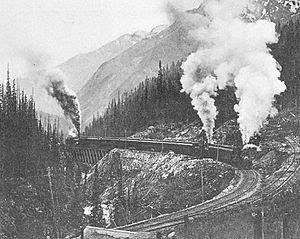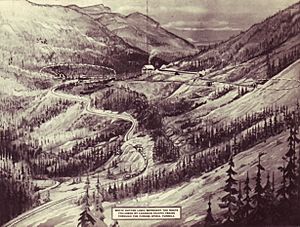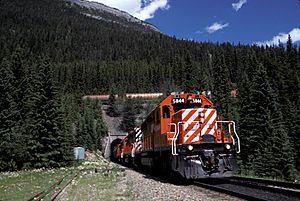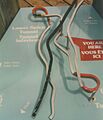Big Hill facts for kids
The Big Hill was a very tough part of the Canadian Pacific Railway (CPR) in British Columbia, Canada. It was in the rugged Canadian Rockies, west of the Continental Divide of the Americas and Kicking Horse Pass. Even after it was replaced by the Spiral Tunnels in 1909, this area is still a challenge for trains today.
Trains had to climb 1,070 feet (330 m) over 10 miles (16 km). They went from Field (4,267 feet (1,301 m)) up to the top of the Continental Divide (5,340 feet (1,630 m)). The narrow valleys and high mountains made it hard to build a gentle slope. This led to later plans to dig tunnels to make the railway less steep.
Contents
Building the Big Hill Line
To finish the railway quickly, a decision was made. Instead of digging a long tunnel through Mount Stephen, a temporary line was built. This line was about 8-mile (13 km) long. It had a very steep slope of 4.5%. This was one of the steepest railway lines anywhere. It went down from Wapta Lake to the Kicking Horse River. Then it went up again to meet the original railway path.
This steep slope was meant to be temporary. It was twice as steep as what was normally allowed for a downhill track. The first construction train to go down the hill had a serious accident. To prevent more accidents, the CPR added three safety switches. These switches led to short tracks that went sharply uphill. They were kept in the uphill position. This was a safety measure. If a train was going too fast, it could be sent onto this uphill track to slow down.
Trains had to go very slowly on the Big Hill. Passenger trains were limited to 8 miles per hour (13 km/h). Freight trains could only go 6 miles per hour (9.7 km/h). All trains also had to have their brakes tested carefully before going down the hill. But even with these rules, accidents still happened often.
Field: A Railway Town
The town of Field was created because of the Big Hill. It was a work camp for the CPR. Trains needed extra locomotives to help them climb the steep hill. A large stone roundhouse with a turntable was built there. In December 1884, the CPR named the town Field. It was named after Cyrus West Field, a businessman from Chicago. The company hoped he might invest in the area.
At that time, most steam locomotives were 4-4-0s. These were good for flat areas. But they were not strong enough for the Big Hill. So, the CPR asked Baldwin Locomotive Works to build special powerful locomotives. These were 2-8-0s, used to push trains up the hill. They were the strongest locomotives built at that time. The CPR later started building its own powerful locomotives.
The Spiral Tunnels Solution
The Big Hill's "temporary" line was used for 25 years. Then, the spiral tunnels opened on September 1, 1909. This was a big improvement.
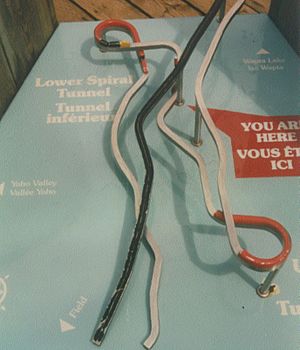
The project to build the tunnels started in 1906. It was led by John Edward Schwitzer, a senior engineer for the CPR. One early idea was to make the climb longer. This would make the slope less steep. But this idea was dropped because of high risks of avalanches. Another idea was to make a horseshoe-shaped loop. But this area also had many avalanches. Avalanches had caused big problems on other parts of the railway. So, Schwitzer decided that digging spiral tunnels was the best, though expensive, way to go.
The chosen plan involved two tunnels. They were dug in three-quarter circles into the valley walls. The higher tunnel, called "number one," is about 1,000 yards (0.91 km) long. It runs under Cathedral Mountain. When a train comes out of this tunnel, it has turned around. It is also 50 feet (15 m) lower than when it entered.
Then, the train goes down the valley side. It crosses the Kicking Horse River. It then enters Mount Ogden into the lower tunnel. This tunnel, "number two," is a bit shorter than "number one." The train drops another 50 feet (15 m) here. After leaving this tunnel, the line continues towards Field. These tunnels effectively double the length of the climb. This reduces the steepness of the slope to 2.2%. The new distance between Field and Wapta Lake is now 11+1⁄2 miles (18.5 km).
The company MacDonnell, Gzowski and Company won the contract to build the tunnels. Work began in 1907. About 1000 workers were involved. The project cost about $1.5 million.
Even with the spiral tunnels, the Field Hill area is still a challenge. Powerful locomotives are still needed at the Field locomotive depot. Even modern trains with special braking systems can have accidents.
Images for kids
-
3D model of the Spiral Tunnels and Highway 1 (black)


